Chapter 17.26
STREET AND STREETSCAPE STANDARDS
Sections:
17.26.030 Street and streetscape standards.
17.26.040 Intersection design.
17.26.010 Purpose.
This chapter provides standards for the design of public streets and the character of the streetscape between buildings along public streets. (Ord. 766 § 2 Exh. A (part), 2004).
17.26.020 Applicability.
Each street in a proposed development project shall be designed in compliance with the standards in Section 17.26.030 of this chapter for the applicable type of street or other public way, the general plan, the city’s standard specifications and details, and as required by the review authority. The street types described in Section 17.26.030 of this chapter may be located within the zoning districts identified in Table 2-17. Street types allowed within a CP (coordinated planning) overlay, or in the PF (public facility) or SP (specific plan) zones shall be determined by the council.
|
|
Street Types Allowed by Zone |
|||||||||||
|---|---|---|---|---|---|---|---|---|---|---|---|---|
|
Street Type |
OSC |
OSR |
RR |
RVL |
NL |
NM |
NU |
CE |
CG |
CD |
CI |
IG |
|
Trail |
|
|
|
|
|
|
|
|
|
|
|
|
|
Path |
|
|
|
|
|
|
|
|
|
|
|
|
|
Alley |
|
|
|
|
|
|
|
|
|
|
|
|
|
Rural Lane |
|
|
|
|
|
|
|
|
|
|
|
|
|
Neighborhood Street |
|
|
|
|
|
|
|
|
|
|
|
|
|
Commercial Street |
|
|
|
|
|
|
|
|
|
|
|
|
|
Crosstown Connector |
|
|
|
|
|
|
|
|
|
|
|
|
|
Industrial Street |
|
|
|
|
|
|
|
|
|
|
|
|
Key: = Street type allowed
(Ord. 766 § 2 Exh. A (part), 2004).
17.26.030 Street and streetscape standards.
Each street and streetscape shall be designed and constructed in compliance with the following standards, in addition to the city’s standard specifications and details, and any requirements of the city engineer. These standards may be modified by the review authority to accommodate existing conditions in a developed area of the city when new street and streetscape improvements are required or constructed.
A. Trail. A trail provides pedestrian access to and through natural settings.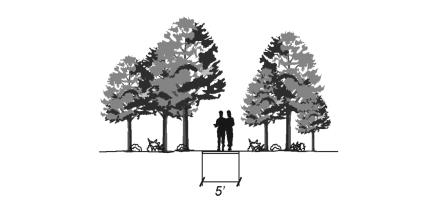
|
Trail Design Standards |
|
|---|---|
|
Walking surface width |
5 ft. minimum |
|
Surfacing material |
Gravel, or other nonpaved, and/or as appropriate for ADA accessibility. |
B. Path. A path provides pedestrian and bicycle access, linking areas of homes, and parks, schools, and shopping.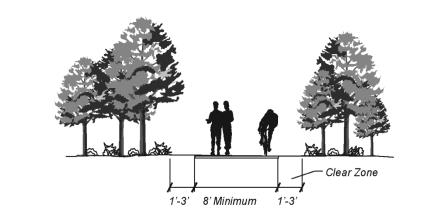
|
Path Design Standards |
|
|---|---|
|
Path width |
8 ft. minimum Clear zone on each side of 1 to 3 ft. |
|
Surfacing material |
Non-petroleum based material, as determined by the review authority to be appropriate for ADA accessibility, bicycles, and strollers. |
|
Landscaping |
Deciduous shade trees |
C. Alley. An alley provides slow speed secondary access to the rear of parcels, and to garages and accessory dwelling units, as well as easy access to utilities and sanitation facilities, and additional access for emergency response.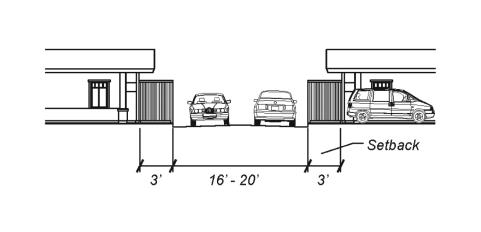
|
Alley Design Standards |
|
|---|---|
|
Total alley width |
16 to 20 ft. as determined by city engineer |
|
Pavement width |
16 to 20 ft., as determined by city engineer |
|
Traffic movement |
Two-way |
|
Traffic lane width |
8 to 10 ft. |
|
Design speed |
10 to 15 mph |
|
Parking |
None |
|
Curb type |
None, except where required by city engineer for proper drainage |
|
Curb radius |
5 ft. |
|
Garage setback from alley |
3 ft. on a 20-foot alley, 5 ft. on a 16-foot alley |
|
Sidewalk width |
None |
|
Planter strip width |
None |
|
Landscaping |
None |
D. Rural Lane. A rural lane provides access to homes in rural areas. Two rural lane standards are provided.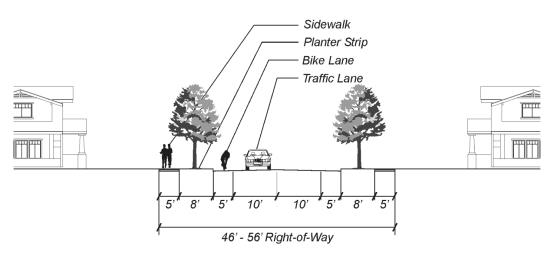
|
Rural Lane 1 Design Standards |
|
|---|---|
|
Total rural lane 1 width |
46 to 56 ft. |
|
Pavement width |
20 to 30 ft. |
|
Traffic movement |
Two-way |
|
Traffic lane width |
10 ft. each |
|
Bike lane width |
5 ft. when a bike lane is required by the review authority |
|
Design speed |
15 to 20 mph |
|
Parking |
Informal within pullouts |
|
Intersection types allowed |
T-intersections preferred |
|
Curb type |
None, or as required by the review authority or city engineer |
|
Curb radius |
N.A. |
|
Sidewalk width |
5 ft. |
|
Planter strip width |
8 ft. |
|
Landscaping |
Deciduous shade trees on both sides of street at 30 ft. on center, in planter strip. |
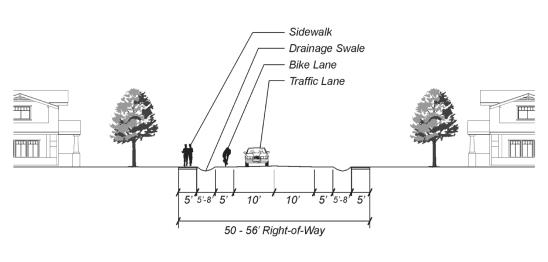
|
Rural Lane 2 Design Standards |
|
|---|---|
|
Total rural lane 2 width |
50 to 56 ft. |
|
Pavement width |
20 ft. |
|
Traffic movement |
Two-way |
|
Traffic lane width |
10 ft. each |
|
Bike lane width |
5 ft. when a bike lane is required by the review authority |
|
Design speed |
15 to 20 mph |
|
Parking |
Informal within pullouts |
|
Intersection types allowed |
T-intersections preferred |
|
Curb type |
None, or as required by the review authority or the city engineer |
|
Curb radius |
N.A. |
|
Sidewalk width |
5 ft. |
|
Planter strip width |
None (5 to 8-foot swale to be provided instead of the planter strip required for rural lane 1). |
|
Landscaping |
Deciduous shade trees on both sides of street at 30 ft. on center, in planter strip |
E. Neighborhood Street. A neighborhood street provides general neighborhood access.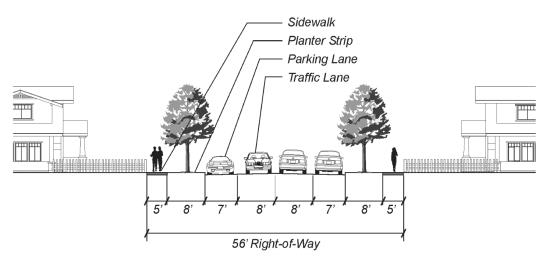
|
Neighborhood Street Design Standards |
|
|---|---|
|
Total neighborhood street width |
56 ft. |
|
Pavement width |
30 ft. |
|
Traffic movement |
Two-way |
|
Traffic lane width |
8 ft. each |
|
Bike lane width |
N.A. |
|
Design speed |
15 to 20 mph |
|
Parking |
On-street both sides, 7-ft. width |
|
Intersection types allowed |
T-intersections preferred |
|
Curb type |
Raised |
|
Curb radius |
15 ft. |
|
Sidewalk width |
5 ft., both sides |
|
Planter strip width |
8 ft., both sides |
|
Landscaping |
Deciduous shade trees on both sides of street at 30 ft. on center, in planter strip. |
F. Commercial Street. A commercial street provides access to, and space for commercial and mixed use buildings.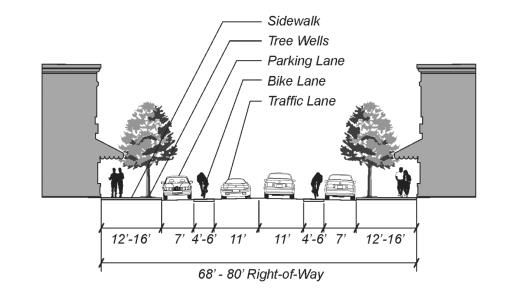
|
Commercial Street Design Standards |
|
|---|---|
|
Total commercial street width |
68 to 80 ft. |
|
Pavement width |
48 ft. |
|
Traffic movement |
Two-way |
|
Traffic lane width |
11 ft., 2 or 4 lanes |
|
Bike lane width |
4 to 6 ft. on each side, when a bike lane is required by the review authority |
|
Design speed |
25 mph |
|
Parking |
On-street both sides, 7-ft. width, or diagonal as required |
|
Intersection types allowed |
T, 4-way |
|
Curb type |
Raised |
|
Curb radius |
25 to 30 ft. |
|
Sidewalk width |
12 to 16 ft. minimum, both sides, with bulbouts at intersections, and mid-block crossings where approved |
|
Planter strip width |
None; tree wells in sidewalk |
|
Landscaped median width |
12 to 16 ft., required for pedestrian refuge on streets with more than 2 lanes |
|
Landscaping |
Deciduous shade trees on both sides of street at 30 ft. on center, in 5-foot square tree wells. |
G. Crosstown Connector. A crosstown connector connects commercial and industrial areas to neighborhoods.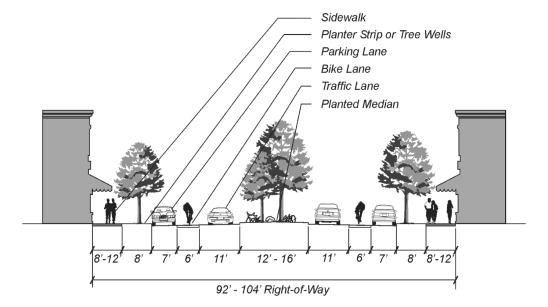
|
Crosstown Connector Design Standards |
|
|---|---|
|
Total crosstown connector width |
92 to 104 ft. |
|
Pavement width |
48 ft. in two 24-ft. segments |
|
Traffic movement |
Two-way |
|
Traffic lane width |
11 ft. |
|
Bike lane width |
6 ft. on each side, when a bike lane is required by the review authority |
|
Design speed |
30 mph |
|
Parking |
On-street both sides, 7-ft. width |
|
Intersection types allowed |
T, 4-way |
|
Curb type |
Raised |
|
Curb radius |
25 ft. |
|
Sidewalk width |
8 to 12 ft., both sides |
|
Planter strip width |
8 ft., both sides, unless tree wells are approved by review authority |
|
Landscaped median width |
12 to 16 ft. median required for pedestrian refuge on streets with more than 2 lanes |
|
Landscaping |
Deciduous shade trees on both sides of street at 30 ft. on center, in planter strip or 5-ft. square tree wells. |
H. Industrial Street. An industrial street provides access to industrial buildings and complexes.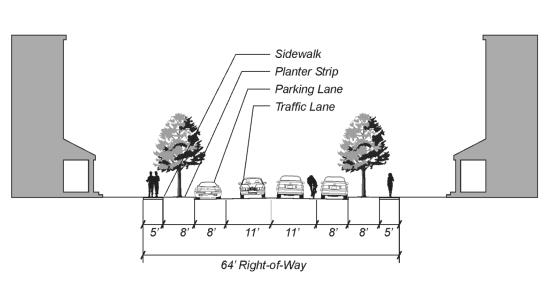
|
Industrial Street Design Standards |
|
|---|---|
|
Total industrial street width |
64 ft. |
|
Pavement width |
38 ft. |
|
Traffic movement |
Two-way |
|
Traffic lane width |
11 ft. |
|
Bike lane width |
N.A. |
|
Design speed |
30 mph |
|
Parking |
On-street both sides, 8-ft. width |
|
Intersection types allowed |
T, 4-way |
|
Curb type |
Raised |
|
Curb radius |
Determined through subdivision process |
|
Sidewalk width |
5 ft., both sides |
|
Planter strip width |
8 ft., both sides |
|
Landscaping |
Deciduous shade trees on both sides of street at 30 ft. on center, in planter strip. |
(Ord. 893 § 6, 2020; Ord. 766 § 2 Exh. A (part), 2004).
17.26.040 Intersection design.
When two of the different street types identified in Section 17.26.030 of this chapter intersect, the intersection design shall comply with the standard for the wider street type. (Ord. 766 § 2 Exh. A (part), 2004).


